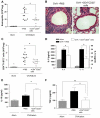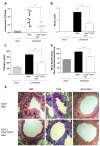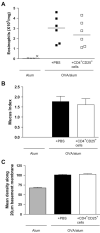CD4+CD25+ regulatory T cells reverse established allergic airway inflammation and prevent airway remodeling
- PMID: 18672278
- PMCID: PMC3389733
- DOI: 10.1016/j.jaci.2008.05.048
CD4+CD25+ regulatory T cells reverse established allergic airway inflammation and prevent airway remodeling
Abstract
Background: CD4(+)CD25(+) regulatory T cells can inhibit excessive T-cell responses in vivo. We have previously demonstrated that prophylactic administration of CD4(+)CD25(+) regulatory T cells suppresses the development of acute allergen-induced airway inflammation in vivo.
Objective: We sought to determine the effect of therapeutic transfer of CD4(+)CD25(+) regulatory T cells on established pulmonary inflammation and the subsequent development of airway remodeling.
Methods: CD4(+)CD25(+) cells were transferred after the onset of allergic inflammation, and airway challenges were continued to induce chronic inflammation and airway remodeling.
Results: Administration of CD4(+)CD25(+) regulatory T cells reduced established lung eosinophilia, T(H)2 infiltration, and expression of IL-5, IL-13, and TGF-beta. Moreover, subsequent mucus hypersecretion and peribronchial collagen deposition were reduced after prolonged challenge. In contrast, transfer of CD4(+)CD25(+) regulatory T cells had no effect on established airway hyperreactivity either 7 days or 4 weeks after transfer.
Conclusions: In this study we demonstrate for the first time that therapeutic transfer of CD4(+)CD25(+) regulatory T cells can resolve features of chronic allergen-induced inflammation and prevent development of airway remodeling.
Figures





References
-
- Chatila TA. Role of regulatory T cells in human diseases. J Allergy Clin Immunol. 2005;116:949–59. - PubMed
-
- Ling EM, Smith T, Nguyen XD, Pridgeon C, Dallman PM, Arbery J, et al. Relation of CD4+CD25+ regulatory T-cell suppression of allergen-driven T-cell activation to atopic status and expression of allergic disease. Lancet. 2004;363:608–15. - PubMed
-
- Joetham A, Takada K, Taube C, Miyahara N, Matsubara S, Koya T, et al. Naturally occurring lung CD4+CD25+ T cell regulation of airway allergic responses depends on IL-10 induction of TGF-beta. J Immunol. 2007;178:1433–42. - PubMed
Publication types
MeSH terms
Substances
Grants and funding
LinkOut - more resources
Full Text Sources
Other Literature Sources
Research Materials

